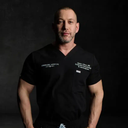I am hesitant to give you a definitive diagnosis without an examination.Please note that the following description may or may not pertain to you.They are general explanations and descriptions of diagnosing and treating skin necrosis.You need to follow up with your doctor and have him or her evaluate you and manage the situation.If your doctor is a board-certified plastic surgeon, then treating skin necrosis is well within their realm of medical practice.If your treating physician is not a board-certified plastic surgeon, then you may want to seek a second opinion by someone who is properly trained to take care of potential complications after liposuction.Skin necrosis does happen after liposuction but on rare locations.It is possible for liposuction to destroy the blood supply that nourishes the skin.When this happens, skin necrosis can be seen.The biggest risk factors for this complication are over-aggressive liposuction, liposuction close to the skin, the use of tobacco products either before or after the procedure, overall poor health and various underlying medical conditions. When a patient develops ischemic skin necrosis, the correct treatment is initial observation.This allows the area of concern to declare itself.This allows the skin that's not going to survive to show itself and let the skin that's going to survive heal and become healthy.The timeframe for this is two to three weeks.When tissue is necrotic and clearly is not going to survive, then it should be removed as soon as possible.Once all necrotic tissue has been removed, the patient needs to undergo wound care, and a definitive plan can then be made regarding treatment of a wound.Treatment options of open wounds is determined by the size of the wound and other variables.Some treatments include allowing the wound to heal slowly by itself with wound care. This is referred to as allowing a wound to heal by secondary intention.Other treatment options include the use of a device known as a VAC. That stands for vacuum-assisted closure.A VAC consists of a sealed dressing over the wound that is connected to a portable suction pump.The pump stays with the person continuously, and the dressing is changed every three days.The use of a VAC will accomplish the same as healing by second intention, though it drastically speeds it up.Other options include skin grafting and, at times, excising the wound followed by sewing the edges together.Some or none of these ideas or principles may or may not apply to you.It is not possible or appropriate for any physician on a forum such as RealSelf to diagnose or treat your condition. Keep in close contact with your doctor and let him or her know of any changes you notice.Hopefully your treating physician is a board-certified plastic surgeon.If so, they will have the skills, experience and knowledge of how to take care of you.If your doctor is not a board-certified plastic surgeon, then you may need to get a second opinion from someone who is competently trained in liposuction and the treatment of potential complications of liposuction.Feel free to contact me directly if you have any specific questions or if I can be of assistance to you. Best of luck,Mats Hagstrom, M.D.


